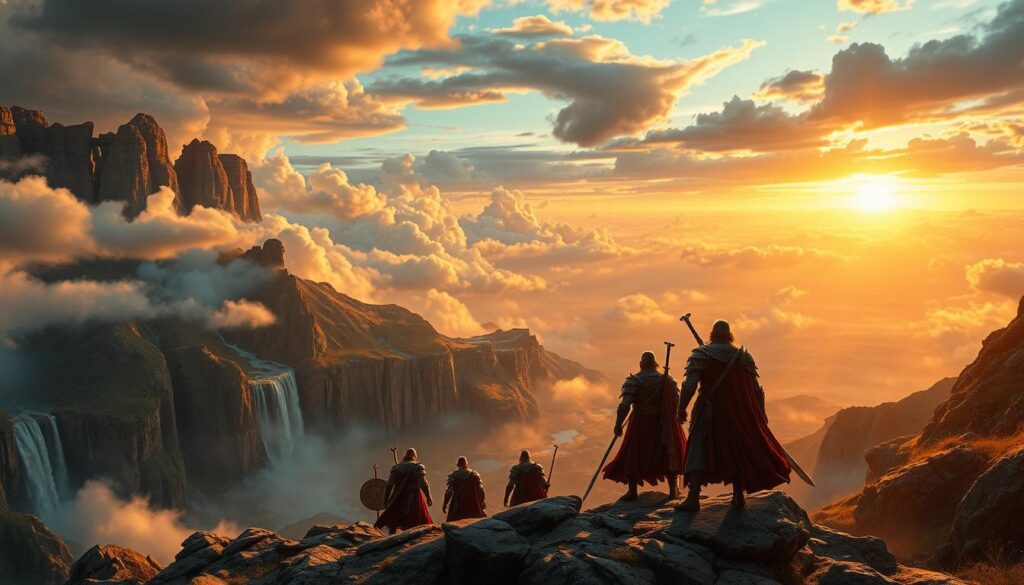Imagine standing before a scene so vast and dramatic, it feels like stepping into a timeless story. For centuries, artists have captured nature’s grandeur, blending raw beauty with tales of courage and adventure. These works don’t just depict mountains, forests, or rivers—they breathe life into legends.
Take Claude, a master painter whose later creations merged lush natural details with themes from ancient epics. Even as his health faded, his art thrived, weaving Virgil’s Aeneid into sunlit valleys and stormy skies. His approach transformed simple vistas into stages for human drama.
This tradition isn’t just about scenery. It’s about how nature mirrors our struggles and triumphs. Think of a misty canyon evoking a hero’s journey or a tranquil lake symbolizing peace after turmoil. Such imagery bridges past and present, reminding us that earth’s beauty has always inspired storytelling.
Today, this legacy lives on. Films, books, and even travel ads echo the monumental style of artists like Claude. Their work proves that landscapes aren’t just backdrops—they’re characters in their own right.
Ready to explore these breathtaking vistas? Let’s dive into how art and nature collide to create something truly unforgettable.
Key Takeaways
- Artistic landscapes often blend natural beauty with historical or literary themes.
- Claude’s late works showcase how health challenges didn’t hinder his creative vision.
- Epic tales like the Aeneid influenced the drama and scale of natural scenes in art.
- Nature’s grandeur has shaped storytelling across centuries, from ancient myths to modern media.
- Exploring these concepts helps us appreciate the deeper narratives behind scenic views.
Embracing the Legacy of Heroic Landscapes
Throughout history, wild terrains have served as stages for human drama. Artists didn’t just paint trees or rivers—they infused rocks and skies with meaning, turning nature into a silent protagonist.
The Mythos Behind Epic Natural Scenes
Ancient myths shaped how we see nature. Greek tales painted mountains as homes of gods, while Norse legends saw forests as gateways to other worlds. Renaissance painters borrowed these ideas, using stormy seas or jagged peaks to symbolize life’s struggles.
Scholars note that 17th-century artworks often hid stories within their scenery. A sunset might hint at a hero’s triumph, while twisted trees echoed tragic fates. As one essay states: “These scenes weren’t decoration—they whispered secrets only the observant could hear.”
How Art Inspires a Sense of Wonder
Great artworks make us feel small yet connected. Think of a painting where sunlight breaks through clouds, casting gold on a valley below. That contrast—tension and hope—mirrors our own journeys.
Modern creators still use these tricks. Filmmakers frame characters against vast deserts to show isolation. Game designers build digital worlds where weather reflects a story’s mood. The goal remains the same: to make nature feel alive.
This tradition proves that earth’s beauty isn’t passive. It challenges, comforts, and changes us—one brushstroke at a time.
Historical Insights and Artistic Mastery
Artists across centuries have redefined how we perceive nature’s grandeur through technical skill and imaginative storytelling. Two masters stand out for their distinct approaches: Claude Lorrain and Théodore Géricault. Their works reveal how light, composition, and literary themes shaped art history.

Claude’s Epic Narratives in Landscape
In his final years, Claude Lorrain shifted toward dramatic storytelling through scenery. His paintings blended golden-hour glows with references to Virgil’s Aeneid, turning forests into stages for mythical quests. Even as his eyesight weakened, he layered delicate brushstrokes to create depth—a technique that made distant mountains feel alive.
Gericault’s Vision: The Times of Day
Théodore Géricault took a different path. His series The Times of Day (published in 1818) used shifting light to mirror human emotions. Dawn’s soft hues suggested hope, while twilight’s shadows hinted at mystery. Measuring 24 x 32 inches, these works balanced precise detail with raw energy—like storm clouds sketched with rapid, confident strokes.
The Comparative Techniques of Past Masters
Claude and Géricault shared a knack for making nature feel consequential. But their methods differed:
- Claude built harmony through gradual color transitions
- Géricault contrasted light and dark for emotional punch
- Both used trees as framing devices—Claude for balance, Géricault for tension
Art historian Dr. Elena Marquez notes: “Their works aren’t just pretty views. They’re visual debates about humanity’s place in the world.” This duality continues to inspire modern artists studying their groundbreaking techniques.
Cultural Significance and Modern Interpretations
From Baroque frames to digital screens, environments have narrated humanity’s evolving saga. What began as coded messages in oil paint now thrives in pixels and panoramas, proving that terrain remains our oldest storyteller.
Landscape as a Storytelling Medium
Seventeenth-century creators treated nature like a visual language. Dutch Golden Age painters hid moral lessons in serene meadows—a withered tree signaling mortality, or a winding path representing life’s uncertainties. As art historian Clara Voss observes: “Every cloud formation held intention, every shadow a subplot.”
From 17th-Century Art to Today’s Perspectives
Modern media reshapes these techniques without losing their essence. Cinematographers frame dystopian cities like modern mountains—looming and symbolic. Video games let players navigate digital wildernesses where weather shifts mirror emotional arcs.
Social media amplifies this tradition. A hiker’s sunset photo isn’t just a view—it’s a shared moment of awe, echoing the communal stories painted centuries ago. Whether through VR or vintage filters, we’re still chasing that timeless thrill: letting the land speak for us.
Conclusion
From mythic tales to modern screens, nature’s grandeur continues to shape our stories. Claude’s twilight-era paintings and Géricault’s light-driven series prove that art isn’t just observed—it’s felt. Their works transformed valleys and storms into cultural touchstones, blending technical skill with timeless themes.
Today’s creators inherit this legacy. Filmmakers frame deserts as metaphors for isolation, while game designers code forests that react to players’ choices. These methods echo 17th-century artists who hid meaning in every shadow and slope.
What endures is nature’s role as both narrator and mirror. Cliffs still symbolize challenges, rivers flow like life’s uncertainties, and dawns promise renewal. This dialogue between earth and imagination spans centuries, inviting us to look deeper.
Ready to see the world through history’s lens? Visit a gallery, watch a film, or simply step outside. Every view holds layers of stories waiting to be discovered—if you know where to look.
